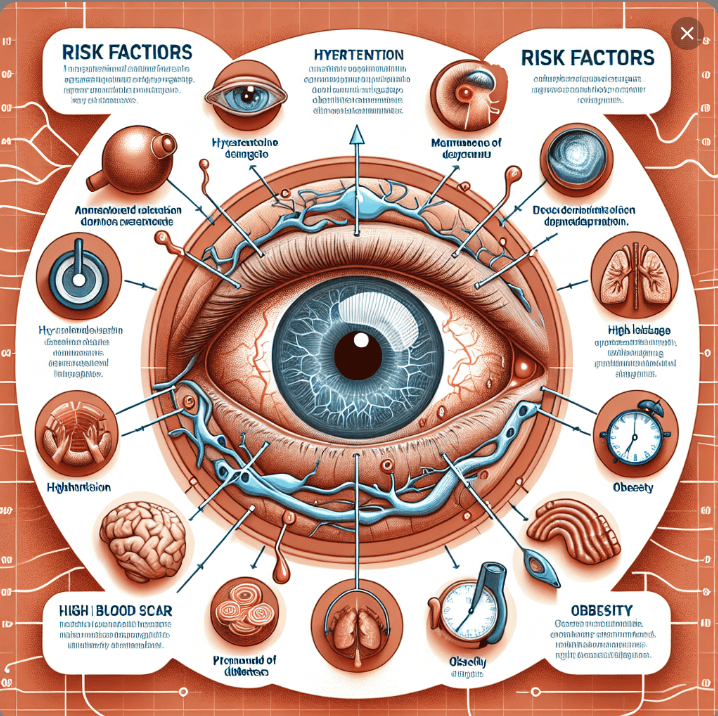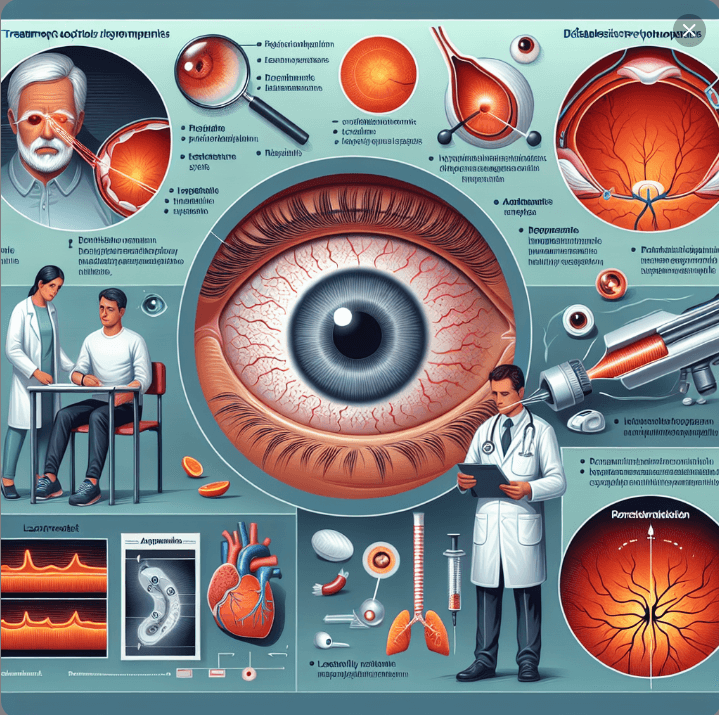Diabetic retinopathy is a silent predator that often goes unnoticed until it’s too late. As one of the most common complications of diabetes, it poses a significant threat to the vision of millions. In India, where diabetes affects a staggering number of individuals, awareness and understanding of diabetic retinopathy are crucial.
It’s not just about managing diabetes; it’s about preserving the gift of sight.
At Jeevansparsh Eye Hospital in Pune, we’re committed to educating our patients and the community about the risks and preventative measures associated with this condition to prevent vision loss effectively.

Contents
- 1 Understanding Diabetic Retinopathy
- 2 Jeevansparsh Eye Hospital’s Approach to Diabetic Retinopathy
- 3 Risk Factors and Symptoms of Diabetic Retinopathy
- 4 Diabetic Retinopathy: Diagnostic Tests and Treatment Strategies
- 5 Treatment Options for Diabetic Retinopathy
- 6 Management Strategies for Diabetic Retinopathy
- 7 Conclusion
Understanding Diabetic Retinopathy
What is Diabetic Retinopathy?
Diabetic retinopathy is a diabetes-induced condition that affects the eyes. It’s caused by damage to the blood vessels of the light-sensitive tissue at the back of the eye (retina). Consistently high blood sugar levels are the culprits, leading to a range of symptoms that can culminate in blindness if left unchecked.
The Stages of Diabetic Retinopathy
Non-Proliferative Diabetic Retinopathy (NPDR): This early stage is marked by the weakening of the retina’s blood vessels, leading to microaneurysms, hemorrhages, and sometimes fluid leakage into the retina. Vision might still be normal, but the groundwork for more severe complications is being laid.
Proliferative Diabetic Retinopathy (PDR): PDR is the more advanced stage, where damaged blood vessels close off, causing the growth of new, abnormal blood vessels on the retina’s surface. These vessels can bleed into the vitreous, potentially leading to retinal detachment and severe vision loss.
Visualizing the Impact
To truly grasp the severity of diabetic retinopathy, one must see it. Illustrated images can be powerful tools for understanding the progression of the disease. They show the tell-tale signs:
- Microaneurysms appear as tiny bulges in the vessels, which can leak fluid and blood.
- Macular swelling, also known as macular edema, can distort vision.
- Abnormal blood vessel growth signifies the proliferative stage, which can lead to serious complications.
The Prevalence of Diabetic Retinopathy in India

India is often referred to as the diabetes capital of the world, with an estimated 77 million individuals affected by the condition, according to the International Diabetes Federation. The prevalence of diabetic retinopathy among these patients is a cause for concern. Research published in the Indian Journal of Ophthalmology found that about 18% of diabetic patients in India have some form of retinopathy.
Jeevansparsh Eye Hospital’s Approach to Diabetic Retinopathy
At Jeevansparsh Eye Hospital, we believe in a proactive approach to diabetic eye care. Our comprehensive diabetic retinopathy management program includes:
- Regular Screening: Early detection through regular eye exams is vital, as diabetic retinopathy often lacks early symptoms.
- Advanced Diagnostic Tools: We use state-of-the-art imaging technology to detect changes in the retina at the earliest stages.
- Personalized Treatment Plans: From laser therapy to surgical interventions, our treatments are tailored to each patient’s unique needs.
- Patient Education: We empower our patients with knowledge about managing their diabetes and protecting their vision.
Risk Factors and Symptoms of Diabetic Retinopathy
Diabetic retinopathy is a serious eye condition that can lead to vision impairment and blindness, particularly among individuals with diabetes. Understanding the risk factors and recognizing the symptoms early on is crucial for timely intervention and management of the disease.
Who is at Risk?
Diabetic retinopathy can affect anyone with diabetes, including those with Type 1, Type 2, and gestational diabetes. However, certain individuals are at a higher risk:
- Prolonged Diabetes: The longer you have diabetes, the greater the risk of developing diabetic retinopathy.
- Uncontrolled Blood Sugar: Poor control of blood sugar levels is a significant risk factor.
- High Blood Pressure: Hypertension increases the risk of diabetic retinopathy.
- High Cholesterol: Elevated cholesterol levels are also a contributing risk factor.
- Smoking: Smoking can exacerbate the damage to your retinal blood vessels.
- Pregnancy: Pregnant women with diabetes should be monitored closely, as they are at increased risk.
- Ethnicity: Individuals of Asian or Afro-Caribbean descent may have a higher risk.
Recognizing the Symptoms
Diabetic retinopathy often starts without any noticeable symptoms. As the condition progresses, symptoms may include:
Early Stages
- Difficulty seeing at night.
- Blurriness or slight vision changes that come and go.
Advanced Stages
- Persistent blurry vision.
- Dark spots or floaters in your vision.
- Pain or pressure in the eyes.
- Difficulty distinguishing colors.
- Vision loss or blindness if left untreated.
It’s important to note that these symptoms can be indicative of other eye conditions as well, so a comprehensive eye examination is essential for a correct diagnosis.
Diagnostic Tests and Regular Examinations
Early detection of diabetic retinopathy is key to managing the condition and preventing severe vision loss. Here are the common diagnostic tests:
- Visual Acuity Test: Measures how well you can read a chart from a distance.
- Tonometry: Assesses the pressure inside your eyes.
- Pupil Dilation: Allows a better view of the retina to check for signs of damage.
- Ophthalmoscopy: Examines the back of the eye.
- Fluorescein Angiography: Highlights leaky blood vessels.
- Optical Coherence Tomography (OCT): Provides detailed images of the retina to detect swelling.
The Importance of Regular Eye Exams
For individuals with diabetes, regular eye exams are not just a recommendation—they are a necessity. These exams can catch diabetic retinopathy in its early stages, even before you notice any symptoms. The American Academy of Ophthalmology suggests that individuals with diabetes should have a comprehensive eye exam at least once a year.
Diabetic Retinopathy: Diagnostic Tests and Treatment Strategies
As a leading eye hospital in Pune, we are committed to providing comprehensive care for patients with diabetic retinopathy, a common yet serious complication of diabetes that affects the eyes. Early detection through regular examinations and effective management strategies is critical to preventing vision loss.
Diagnostic Tests for Diabetic Retinopathy
To accurately diagnose diabetic retinopathy and assess the extent of retinal damage, we employ a range of diagnostic tests:
- Visual Acuity Test: This test measures the smallest letters you can read on a standardized chart to determine the clarity of your vision.
- Tonometry: This procedure assesses the pressure inside the eye, which can indicate the presence of glaucoma, a condition that diabetic patients are at higher risk of developing.
- Pupil Dilation: By dilating the pupils with eye drops, we can obtain a better view of the retina to check for signs of diabetic retinopathy.
- Ophthalmoscopy: This instrument allows us to examine the back of the eye, including the retina, optic disk, and underlying blood vessels.
- Fluorescein Angiography: A special dye is injected into the bloodstream to highlight the blood vessels in the back of the eye so we can photograph and identify any leakage or abnormal growth.
- Optical Coherence Tomography (OCT): OCT provides high-resolution cross-sectional images of the retina, which can reveal swelling and other changes that may not be visible with other methods.
Treatment Options for Diabetic Retinopathy
When it comes to treating diabetic retinopathy, we offer several options tailored to the specific needs of the patient:
- Laser Surgery: This treatment, known as photocoagulation, can stop or slow the leakage of blood and fluid in the eye.
- Vitrectomy: In advanced cases, this surgery removes blood from the middle of the eye.
- Injections: Anti-VEGF drugs can be injected into the eye to slow the growth of new blood vessels and reduce fluid buildup.
The choice of treatment depends on the stage of the disease, whether the patient is pregnant, and other health considerations.
Management Strategies for Diabetic Retinopathy
Effective management of diabetic retinopathy extends beyond medical procedures:
- Blood Sugar Control: Keeping blood sugar levels within a target range can significantly slow the progression of diabetic retinopathy.
- Lifestyle Modifications: Diet, exercise, and quitting smoking can all contribute to better overall health and reduce the risk of complications.
Conclusion
In conclusion, diabetic retinopathy is a condition that requires immediate attention and ongoing care. At our eye hospital in Pune, we are equipped with the latest technology and expertise to diagnose and treat this eye disease effectively. We believe in a proactive approach to eye health, especially for those living with diabetes.
Don’t wait until symptoms appear. Contact us here!


